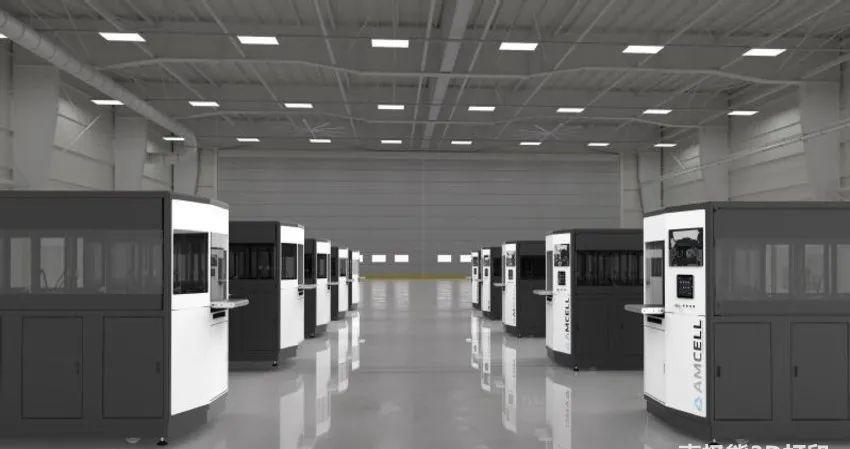In April 2022, Antarctic Bear learned that Taiwanese electronics giant Foxconn and Spanish company Triditive, a global additive manufacturing benchmark, have joined forces to develop a metal 3D printer that utilizes adhesive injection technology. For several years, Triditive has been developing and commercializing tailor-made metal extrusion systems for parts under the AMCELL brand. Triditive and Foxconn will now collaborate to further expand the automated manufacturing capabilities of 3D printing platforms, a major turning point.

△CELL 3D printers
Binder jet 3D printing technology, belonging to the "powder bed" or "additive manufacturing technology based on sintering technology". The main process steps include laying a layer of metal powder, which selectively deposits the adhesive through the print head, connecting the metal particles together. Repeat layer by layer to get the embryo. It is then placed in a furnace for degreasing and sintering, and the adhesive is burned off, resulting in metal parts with highly complex geometries. Triditive's experience in combining metal extrusion, also a sintering-based process, will help Foxconn enter competing markets with giants such as HP, General Electric and Desktop Metal.
What makes this technology special is the scalability of production, the reduction in the cost of manufacturing metal parts, and the fact that large-scale applications have become more attractive. However, the development of metal adhesive jets for high-volume part production has been slowed by a number of challenges, mostly related to the post-sintering process.
△ Triditive's automated 3D printing production workshop
For the development of "adhesives", Triditive will work with Tecnalia, a research and technology development center in the Basque Country of Spain, and with the German technology center Fraunhofer to select and optimize metal powders.
Compared to existing technologies, adhesive jetting technology aims to introduce a method of manufacturing metal parts faster in an additive process. For this purpose, the inkjet printhead offers high precision; even very small details can be reproduced.
It should be noted that the process does not require the use of support structures and excess powder can be reused. On the other hand, the level of surface finish and the mechanical properties of the resulting part make it ideal for end-use applications.
These conditions allow for the expansion and optimization of production at a time when inventory and material issues pose a global industrial challenge, in addition to reducing costs.
Foxconn is one of the largest companies in the tech space and is a foundry for giants such as Apple, Sony and Intel. While it is considered a big manufacturer using mold and prototyping techniques, this is the first time the manufacturing giant has been directly involved in and developing 3D printing equipment in-house. The deployment of 3D printing in production is currently being considered to reduce highly labor-intensive tasks and increase the degree of automation of production.
Regarding this new production system, Triditive holds a patent for automation machinery in Spain and is a leader in the field of international additive manufacturing. These features make it an ideal partner for the world's largest manufacturer of electronic components.
Powerful AMCELL 3D printing automation factory
Antarctic Bear found that the Spanish 3D printing manufacturer Triditive's 3D printing production line AMCELL 8300, with a very high degree of automation, can be used as a typical representative of the future 3D printing manufacturing production line automation.
The AMCELL 8300 is a large-scale 3D printer solution capable of mass production of metal and polymer parts, making additive manufacturing a viable solution for high-volume manufacturing, with 24/7 × to produce functional parts.
Manufacture of high-precision functional parts
polymer
Composites
metal
High tolerance quality (ISO 2768)
Mass production
Powerful EVEM industrial software
Centralized control and monitoring
Intelligent control of raw materials
Production optimization
Printer integration
Build the simulation
dispatch
Workshop connection
Quality and process monitoring
Traceability
Software-controlled workflow and process monitoring
The MCELL 8300 includes the advanced production control and remote monitoring solution EVAM Software
Automatic calibration
Each printhead is automatically calibrated before each print job to ensure the highest quality of the final part.
Automatic 3D printing of parts
The printed parts are ejected to the automatic enclosure and loaded with the new platform to ensure 24/7 production.
Automatic storage
Traceability and automatic storage of prints.
Technical specifications
Technical information
Additive Manufacturing Technology: Automated Multimaterial Deposition (AMD Technology)
Construction speed: 8 tons of metal/year - 2 tons of polymer/year
Maximum print height: 350 mm
Maximum print diameter: 300 mm
Extruder system: titanium
Nozzle diameter: 0.4 - 0.8 mm
Manufacturing materials
Polymers: ABS, ASA, CPE, HIPS, IGLIDUR I150, PA, PC, PETG, PLA, PP, TPU, vinyl.
Composites: PA+ARAMIDE, PA+CF, PC+ABS, PC+PBT.
Metals: SS 316, SS 17-4 PH, Inconel, Titanium.
Minimum floor height: 30 μm
Number of robots: 8 (customizable)
Construction chamber: temperature controlled heating, filtration system
Dimensions and weight dimensions: 3,4 x 2 x 2 meters.
Empty load: 1300 kg. Loading weight: 1700 kg
Manufacturing platform
Platform Replacement System: Automatic
Ejection system: STEP system
Build the platform: heated, up to 150°C
Building platform material: tempered glass (customizable)
Build platform calibration: Automatic
Final part storage: Automatic TRAC3